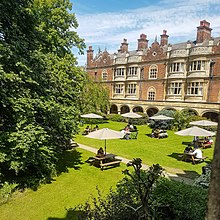
Back Coleg Sidney Sussex, Caergrawnt Welsh Sidney Sussex College (Cambridge) Spanish Sidney Sussex College Finnish Sidney Sussex College French Sidney Sussex College Italian Collegium Sidney Sussex (Cantabrigia) Latin Sidney Sussex College NB Сидни-Сассекс-колледж (Кембридж) Russian Sidney Sussex College, Cambridge SIMPLE سڈنی سسیکس کالج، کیمبرج Urdu
| Sidney Sussex College | |
|---|---|
| University of Cambridge | |
 Cloister Court, Sidney Sussex College | |
 Arms of Sidney Sussex College, being the arms of the foundress Frances Sidney, Countess of Sussex | |
| Scarf colours: two equal halves of dark-red and navy Sidney Sussex College scarf | |
| Location | Sidney Street (map) |
| Full name | The College of the Lady Frances Sidney Sussex |
| Abbreviation | SID[1] |
| Motto | Dieu me garde de calomnie (Middle French) |
| Motto in English | God preserve me from calumny |
| Founder | Frances Sidney, Countess of Sussex |
| Established | 1596 |
| Sister college | St John's College, Oxford |
| Master | Martin Burton |
| Undergraduates | 396 (2022-23) |
| Postgraduates | 240 (2022-23) |
| Fellows | 80 |
| Endowment | £29m (2022)[2] |
| Visitor | |
| Website | www |
| Sidney Sussex College Students' Union (SSCSU) | sscsu |
| MCR | www |
Sidney Sussex College (referred to informally as "Sidney") is a constituent college of the University of Cambridge[4] in England. The College was founded in 1596 under the terms of the will of Frances Sidney, Countess of Sussex (1531–1589), wife of Thomas Radclyffe, 3rd Earl of Sussex, and named after its foundress. In her will, Lady Sidney left the sum of £5,000 together with some plate to found a new College at Cambridge University "to be called the Lady Frances Sidney Sussex College".[5] Her executors Sir John Harington and Henry Grey, 6th Earl of Kent, supervised by Archbishop John Whitgift, founded the Protestant College seven years after her death.[6]
Sir Benjamin Lockspeiser, the first president of CERN was also an undergraduate at the college, along with psychiatrist W. Ross Ashby. Robert McCance Professor of Experimental Medicine, played a leading part in wartime rationing and 1940s government nutrition efforts. Professor Dame Ann Dowling has been a Fellow since 1977 and is the President of the Royal Academy of Engineering.[7] The inaugural recipient of the Rosalind Franklin award Professor Sue Gibson was an undergraduate at the college.[8] The "father of radio astronomy in Australia"[9][10] Joe Pawsey obtained his PhD at Sidney Sussex in 1935.
Sidney Sussex is one of the smaller colleges at Cambridge, with its sister college being St John's College, Oxford.[11] The student body comprises approximately 355 undergraduates, 275 postgraduates, and around 80 fellows.
- ^ University of Cambridge (6 March 2019). "Notice by the Editor". Cambridge University Reporter. 149 (Special No 5): 1. Retrieved 20 March 2019.
- ^ "Annual report and Financial Statements for the year ended 30 June 2022" (PDF). Sidney Sussex College, Cambridge. Retrieved 8 July 2023.
- ^ Cite error: The named reference
sid-cam-statuteswas invoked but never defined (see the help page). - ^ Walker, Timea (2 February 2022). "Sidney Sussex College". www.undergraduate.study.cam.ac.uk. Retrieved 2 November 2022.
- ^ Hearn, Karen, ed. Dynasties: Painting in Tudor and Jacobean England 1530–1630, p. 95
- ^ Cite error: The named reference
sid.cam.ac.ukwas invoked but never defined (see the help page). - ^ "Dame Ann Dowling". raeng.org.uk. Retrieved 9 March 2017.
- ^ "Professor Sue Gibson OBE CChem FRSC". www.rsc.org. Retrieved 9 March 2017.
- ^ Moyal, Ann (1994). Portraits in science. Canberra: National Library of Australia. p. 43. ISBN 0642106169.
- ^ Bhathal, Ragbir (1996). Australian astronomers: achievements at the frontiers of astronomy. Canberra: National Library of Australia. p. 72. ISBN 0642106665.
- ^ "Sidney Sussex College". Cambridge Colleges. Retrieved 8 October 2024.